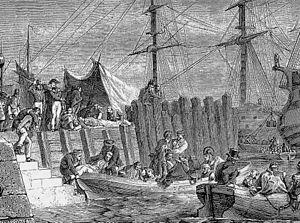| Walcheren Campaign | |||||||
|---|---|---|---|---|---|---|---|
| Part of the War of the Fifth Coalition | |||||||
 Illness-stricken British forces evacuating Walcheren on 30 August | |||||||
| |||||||
| Belligerents | |||||||
|
|
| ||||||
| Commanders and leaders | |||||||
|
|
| ||||||
| Strength | |||||||
|
July: 20,000 August: 46,000 |
39,000 616 ships | ||||||
| Casualties and losses | |||||||
|
4,000 dead, wounded or captured 5,000+ sick |
4,150 dead, wounded or captured 12,000+ sick | ||||||
Walcheren Campaign
The Walcheren Campaign ([ˈʋɑlxərə(n)] WAHL-khə-rən) was an unsuccessful British expedition to the Kingdom of Holland in 1809 intended to open another front in the Austrian Empire's struggle with France during the War of the Fifth Coalition. John Pitt, 2nd Earl of Chatham, the commander of the expedition, was ordered to capture the towns of Flushing and Antwerp and thus enable British ships to safely traverse the Scheldt River.
A British expeditionary force of 39,000 troops, together with field artillery and two siege trains, crossed the North Sea and landed at Walcheren on 30 July. This was the largest British expedition of that year, larger than the army serving in the Peninsular War in the Iberian Peninsula. Nevertheless, it failed to achieve any of its goals. The campaign involved little fighting, but heavy losses from the sickness popularly dubbed "Walcheren Fever". Although more than 4,000 British troops died during the expedition, only 106 were killed in action; the survivors withdrew on 9 December. Defending Franco-Dutch forces also suffered heavy casualties, including 4,000 men dead, wounded or captured.[1]
- ^ Brett-James 1963, pp. 811–820.
